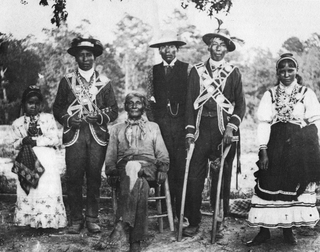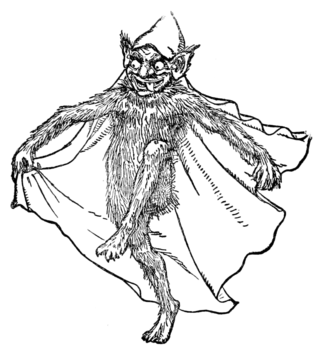
A dwarf is a type of supernatural being in Germanic folklore. Accounts of dwarfs vary significantly throughout history; however, they are commonly, but not exclusively, presented as living in mountains or stones and being skilled craftspeople. In early literary sources, only males are explicitly referred to as dwarfs. However, they are described as having sisters and daughters, while male and female dwarfs feature in later saga literature and folklore. Dwarfs are sometimes described as short; however, scholars have noted that this is neither explicit nor relevant to their roles in the earliest sources.

A fairy is a type of mythical being or legendary creature, generally described as anthropomorphic, found in the folklore of multiple European cultures, a form of spirit, often with metaphysical, supernatural, or preternatural qualities.

Choctaw mythology is part of the culture of the Choctaw, a Native American tribe originally occupying a large territory in the present-day Southeastern United States: much of the states of Mississippi, Alabama, and Louisiana. In the 19th century, the Choctaw were known to European Americans as one of the "Five Civilized Tribes" even though controversy surrounds their removal.

The Indigenous peoples of the Americas comprise numerous different cultures. Each has its own mythologies, many of which share certain themes across cultural boundaries. In North American mythologies, common themes include a close relation to nature and animals as well as belief in a Great Spirit that is conceived of in various ways.
David MacRitchie was a Scottish folklorist and antiquarian. He proposed that stories of fairies originated with an aboriginal race that occupied the British Isles before Celts and other groups arrived.
The Multnomah are a tribe of Chinookan people who live in the area of Portland, Oregon, in the United States. Multnomah villages were located throughout the Portland basin and on both sides of the Columbia River. The Multnomah speak a dialect of the Upper Chinookan language in the Oregon Penutian family.

The San Pedro Mountains mummy is a mummy discovered in Wyoming in the 1930s and since lost. Scientific analyses have concluded that it is the mummy of a Native American infant that was born with anencephaly, but due to its small size and unusual physical features, it was the source of theories that it constituted an early hominid and related to legends of little people. A similar mummy that was studied in the 1990s has been nicknamed "Chiquita".
The Nimerigar are a legendary race of little people found in the folklore of the Shoshone people of North America's Rocky Mountains.
Mythic humanoids are legendary, folkloric, or mythological creatures that are part human, or that resemble humans through appearance or character. Each culture has different mythical creatures that come from many different origins, and many of these creatures are humanoids. They are often able to talk and in many stories they guide the hero on their journey.

In mythology and the study of folklore and religion, a trickster is a character in a story who exhibits a great degree of intellect or secret knowledge and uses it to play tricks or otherwise disobey normal rules and defy conventional behavior.

The high visibility of the star cluster Pleiades in the night sky and its position along the ecliptic has given it importance in many cultures, ancient and modern. Its heliacal rising, which moves through the seasons over millennia was nonetheless a date of folklore or ritual for various ancestral groups, so too its yearly heliacal setting.

A goblin is a small, grotesque, monstrous creature that appears in the folklore of multiple European cultures. First attested in stories from the Middle Ages, they are ascribed conflicting abilities, temperaments, and appearances depending on the story and country of origin, ranging from mischievous household spirits to malicious, bestial thieves. They often have magical abilities similar to a fairy or demon, such as the ability to shapeshift.
There are a vast array of myths surrounding the Blackfoot Native Americans as well as Aboriginal people. The Blackfeet inhabit the Great Plains, in the areas known as Alberta, Saskatchewan, and areas of Montana. These stories, myths, origins, and legends play a big role in their everyday life, such as their religion, their history, and their beliefs. Only the elders of the Blackfoot tribes are allowed to tell the tales, and are typically difficult to obtain because the elders of the tribes are often reluctant to tell them to strangers who are not of the tribe. People such as George B. Grinnell, John Maclean, D.C. Duvall, Clark Wissler, and James Willard Schultz were able to obtain and record a number of the stories that are told by the tribes.

The Tukudeka or Mountain Sheepeaters are a band of Shoshone within the Eastern Shoshone and the Northern Shoshone. Before the reservation era, they traditionally lived in the central Sawtooth Range of Idaho and the mountains of what is now northwest Wyoming. Bands were very fluid and nomadic, and they often interacted with and intermarried other bands of Shoshone. Today the Tukudeka are enrolled in the federally recognized Shoshone-Bannock Tribes of the Fort Hall Reservation of Idaho and the Eastern Shoshone of the Wind River Indian Reservation in Wyoming.

The Pryor Mountains are a mountain range in Carbon and Big Horn counties of Montana, and Big Horn County, Wyoming. They are located on the Crow Indian Reservation and the Custer National Forest, and portions of them are on private land. They lie south of Billings, Montana, and north of Lovell, Wyoming.

The Little People of the Pryor Mountains are a race of ferocious dwarfs in the folklore of the Crow Nation, a Native American tribe. The Little People were also seen as imparting spiritual wisdom, and played a major role in shaping the destiny of the Crow People through the dreams of the iconic Crow chief, Plenty Coups.

Spirit Mound Historic Prairie is a state park of South Dakota, US, featuring a prominent hill on the Great Plains. The Plains Indians of the region considered Spirit Mound the home of dangerous spirits or little people; members of the Lewis and Clark Expedition climbed it on August 25, 1804. The park was established in 2002. It is located about 6.5 miles (10.5 km) north of Vermillion, South Dakota.

In Australian Aboriginal religion and mythology, Crow is a trickster, culture hero and ancestral being. In the Kulin nation in central Victoria he is known as Waang and is regarded as one of two moiety ancestors, the other being the more sombre eaglehawk Bunjil. Legends relating to Crow have been observed in various Aboriginal language groups and cultures across Australia.

Canadian folklore is the traditional material that Canadians pass down from generation to generation, either as oral literature or "by custom or practice". It includes songs, legends, jokes, rhymes, proverbs, weather lore, superstitions, and practices such as traditional food-making and craft-making. The largest bodies of folklore in Canada belong to the aboriginal and French-Canadian cultures. English-Canadian folklore and the folklore of recent immigrant groups have added to the country's folk.















